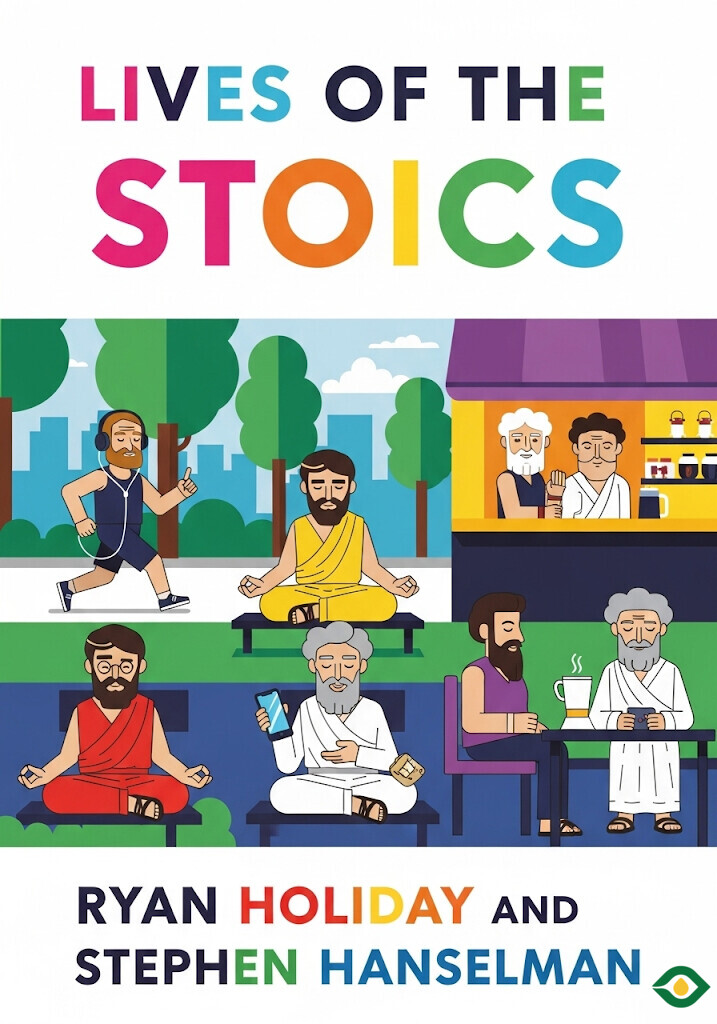Description
At its heart, Stoicism is about one simple but powerful question: How should I live? The Stoics believed the answer lay not in wealth, fame, or pleasure, but in virtue. Virtue, to them, was the highest good, and it came down to four main qualities: courage, wisdom, moderation, and justice. These were not abstract ideas but practical tools for everyday life. For the Stoics, philosophy was not about endless debate or clever words — it was about how you lived, how you reacted to hardship, and how you treated others.
The story of Stoicism begins with Zeno of Cyprus, a merchant whose fortune was destroyed in a shipwreck. Most people would have collapsed under such a blow, but Zeno chose to embrace fate. Instead of despair, he turned to philosophy and moved to Athens. There, he studied under different teachers, eventually starting his own school on a public porch, the Stoa Poikile, from which Stoicism takes its name. Zeno taught that true happiness comes from living in harmony with virtue, not from chasing status or possessions.
One of Zeno’s most loyal students was Cleanthes. Unlike Zeno, he came from poverty and worked as a water-carrier even while studying philosophy. He refused handouts from wealthy patrons, insisting instead on hard labor. Cleanthes believed that honest work shaped character, and he lived with extreme frugality, sometimes writing his ideas on oyster shells instead of paper. People mocked him for being slow, but he remained steady and disciplined, dedicating his long life to wisdom. His example showed that philosophy is not about comfort or applause, but about persistence and humility.
Another powerful example of Stoicism in action comes from Cato the Younger, a Roman statesman known for his incorruptibility. From childhood, Cato showed unusual courage and independence. As a senator, he became famous for refusing bribes, working longer hours than anyone else, and rejecting luxuries. He stood against the corruption of Rome, even when it made him unpopular. Cato’s fierce dedication to justice put him in direct opposition to Julius Caesar’s rise to power. Rather than live under tyranny, Cato chose death by his own hand. His life became a symbol of integrity, and his death showed the Stoic belief that virtue is worth more than survival.
Cato’s daughter, Porcia, carried on his spirit. Married to Brutus, one of the men who plotted Caesar’s assassination, she wanted to prove that she was strong enough to be trusted with dangerous secrets. Instead of asking for words, she gave proof through action: she stabbed her own thigh to show she could endure pain. When Brutus saw her resilience, he confided in her. Later, when Brutus was killed in civil war, Porcia refused to live under oppression. According to some accounts, she ended her life by swallowing hot coals. Though her story is tragic, it shows the Stoic idea that courage and inner strength belong to both men and women.
Perhaps the most famous Stoic is Seneca, a philosopher, playwright, and tutor to the Roman emperor Nero. Seneca wrote beautifully about morality, self-control, and the shortness of life, urging people to focus on what truly matters. Yet his life was full of contradictions. Though he tried to guide Nero with wisdom, he remained in the emperor’s service even as Nero committed terrible crimes. Seneca became wealthy and powerful, far from the simple life many Stoics valued. In the end, when he was accused of joining a plot against Nero, Seneca was ordered to take his own life. His death — slow and painful — reflected his writings about facing mortality with calm acceptance. Seneca’s story reminds us that living up to Stoic ideals is difficult, even for those who teach them.
Another major Stoic figure was Epictetus, who lived in Rome many years later. Unlike Zeno or Seneca, Epictetus began life as a slave. He experienced firsthand the loss of freedom and the hardships of being controlled by others. When he finally gained freedom, he dedicated himself to philosophy. His teachings focused on what we can and cannot control. He said that in any situation, we have two “handles” to choose from: one leads to despair, the other to strength. While we cannot control events, we can always control how we respond. Epictetus urged his students to persist in virtue and resist temptation. For him, true freedom was not political power or wealth, but mastery over one’s own mind.
The final great Stoic was Marcus Aurelius, a Roman emperor who became known as the “philosopher king.” Unlike many rulers, Marcus did not let power corrupt him. He practiced humility, often visiting his teachers rather than forcing them to come to his palace. He even shared rule with a co-emperor, an unusual act in a world of ruthless politics. When Rome was struck by plague, Marcus did not burden his people with higher taxes. Instead, he sold his own treasures to fund relief.
Marcus Aurelius also left behind a personal journal of reflections, now known as Meditations. In it, he recorded his struggles with anger, envy, and fear, and how he tried to overcome them using Stoic principles. These writings were not meant for the public but for himself, as a way of holding himself accountable. His honesty makes his words deeply relatable, even centuries later. Marcus showed that Stoicism is not about being emotionless but about working every day to be wiser, calmer, and kinder.
Taken together, the lives of these Stoics illustrate what it means to put philosophy into practice. Zeno taught resilience after loss. Cleanthes embodied discipline and hard work. Cato showed unwavering commitment to justice, and Porcia displayed fearless courage. Seneca revealed both the power and the difficulty of living with integrity. Epictetus proved that even in chains, the mind can be free. Marcus Aurelius demonstrated how wisdom can guide even the most powerful.
The Stoics believed that life is short and uncertain. Fortune can take away wealth, health, and status in an instant. But what it cannot take is our character, our choices, and our response to events. This is where true freedom lies. By practicing courage, wisdom, moderation, and justice, the Stoics believed anyone could live a life worth remembering.
In the end, Stoicism is not about grand theories but about daily actions. It is not about what we say but what we do. The Stoics remind us that virtue is the only secure foundation for happiness. Their lives — full of hardship, triumph, contradictions, and lessons — continue to inspire us to live with strength, clarity, and purpose.





